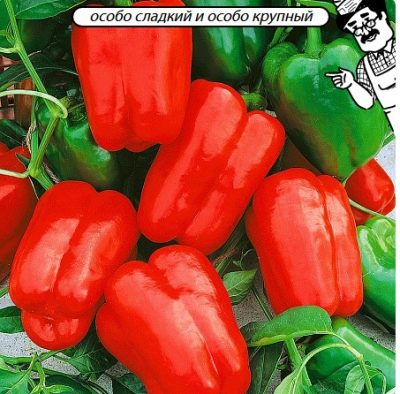
- Authors: Sakata
- Name synonyms: Ombrone
- Year of approval: 2010
- Bush height, cm: 60-100
- Growth type: medium-sized, vigorous
- Fruit shape: cylindrical
- Fruit weight, g: 171-400
- Fruit color: in technical ripeness green to dark green, in biological ripeness red
- Ripening terms: mid-season
- Ripening month: July August September
Sweet pepper hybrids are always more resistant to harsh climatic conditions, better taste, and give higher yields than varietal crops. All these qualities are fully inherent in the hybrid variety Ombrone F1.
Breeding history
The famous Japanese company Sakata became the creator of this culture. For over 100 years, since 1913, the main activity of this large seed company has been the selection of vegetable crops. In 2010, the resulting hybrid variety Ombrone was entered in the State Register of the Russian Federation for growing outdoors in the southern regions of the country in personal subsidiary plots.
Description of the variety
Despite the recommendations of Rosreestr, this variety of red sweet pepper is suitable for cultivation both in protected and in open ground. Moreover, the fruits of this Japanese culture are able to effectively set even at low temperatures.
Ombrone pepper of medium early ripening period, unpretentious in care, can well withstand any unfavorable environmental factors, as well as transportation.
Characteristics of the appearance of plants and fruits
The Ombrone bush is semi-sprawling, powerful, vigorous. The height cannot be called too high - from 60 cm to a meter. The leaves are wrinkled, medium in size, can be dark green or green.
Pepper has a cylindrical shape, sometimes cuboid, elongated, with a blunt tip. Thick-walled, wall thickness 8 mm. The fruits are large. In length they reach 15-18 cm, in diameter - 10-12 cm, average weight - 171-400 grams. When the pepper is fully ripe, the dark green color changes to bright red.
Purpose and taste
Ombrone is distinguished by rather large fruits. The taste is balanced, bright, and lasts even after freezing. Peppers are sweet, juicy, absolutely without bitterness. They are good both in fresh salads and in preserves.
Ripening terms
Mid-season hybrid. The fruits will ripen 70-75 days after transplanting the seedlings to a permanent place. The ripening period is from July to September.
Yield
On average, 5.8 kilograms of fruit can be obtained from one square meter.

To get a large and tasty harvest of pepper, you need to take care of the seedlings in advance. When growing pepper seedlings, you need to correctly determine the sowing time, pre-sowing seed treatment, prepare the necessary container and soil.
Growing and care
Ombrone hybrid pepper is recommended to grow by seedling method. To ensure an earlier harvest, the procedure is carried out without picking. Sweet peppers should not be planted next to spicy peppers, otherwise the sweet fruits will start to taste bitter.
Ombrone pepper is recommended to be watered once a week if the air temperature is moderate. If it is hot, watering is increased and the crop is irrigated 2 times a week. The variety does not tolerate either drying out of the soil or its excessive moisture. If, when the foliage and ovaries dry out, they crumble, then during overflow the roots can rot due to insufficient oxygen.
The hybrid variety prefers light, loose soil that is sufficiently organic and pH neutral.The substrate for peppers should contain the required amount of magnesium and potassium, but without chlorine, otherwise the plant will have a decrease in its flowering rate. After planting in the garden, the pepper bushes must be fertilized every 2 weeks, while mineral fertilizers and organic matter alternate.
Peppers will grow well after crops such as carrots, cabbage, beets, pumpkin. Does not like a hybrid pepper variety with cucumbers.

To harvest a tasty and rich harvest of pepper, you need to comply with all the conditions of agricultural technology, and proper care begins with planting plants. Before planting pepper in open ground, it should be prepared. It is also important to take care of the seedlings and planting space in advance.




For good growth of pepper bushes and active fruiting, you need to regularly apply mineral and organic fertilizing to the soil. It is necessary not only to choose the right formulations, but also to use them at the right stage in the development of culture. The frequency of top dressing is always individual. It depends directly on the composition of the land on your site. The poorer the soil composition, the more often you will need to feed the pepper.
Disease and pest resistance
The Ombrone hybrid has good resistance to major pepper diseases and attacks from harmful insects. However, as a preventive measure, it will not hurt to treat the bushes with Bordeaux liquid once every 2 weeks. At the first signs of disease, the culture is treated with solutions of fungicides, and the affected plants or their fragments are removed and burned.

Pepper is one of the most common vegetables in home gardens. This culture is quite stable and unpretentious. However, under certain conditions, this plant can suffer from infections and harmful insects. Before treating peppers for diseases or pests, you need to find out the cause of the problem, otherwise the treatment may be ineffective.





















































































